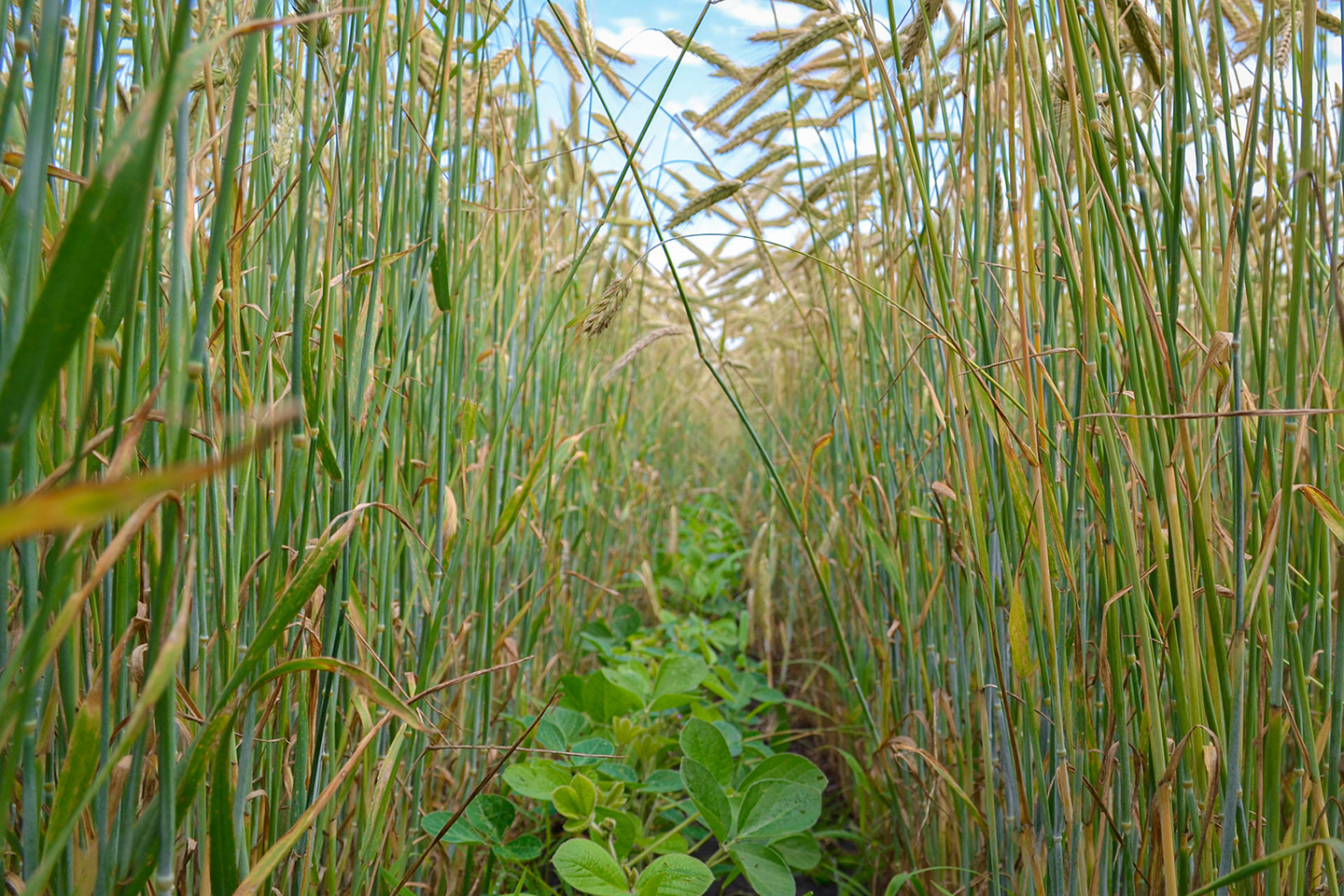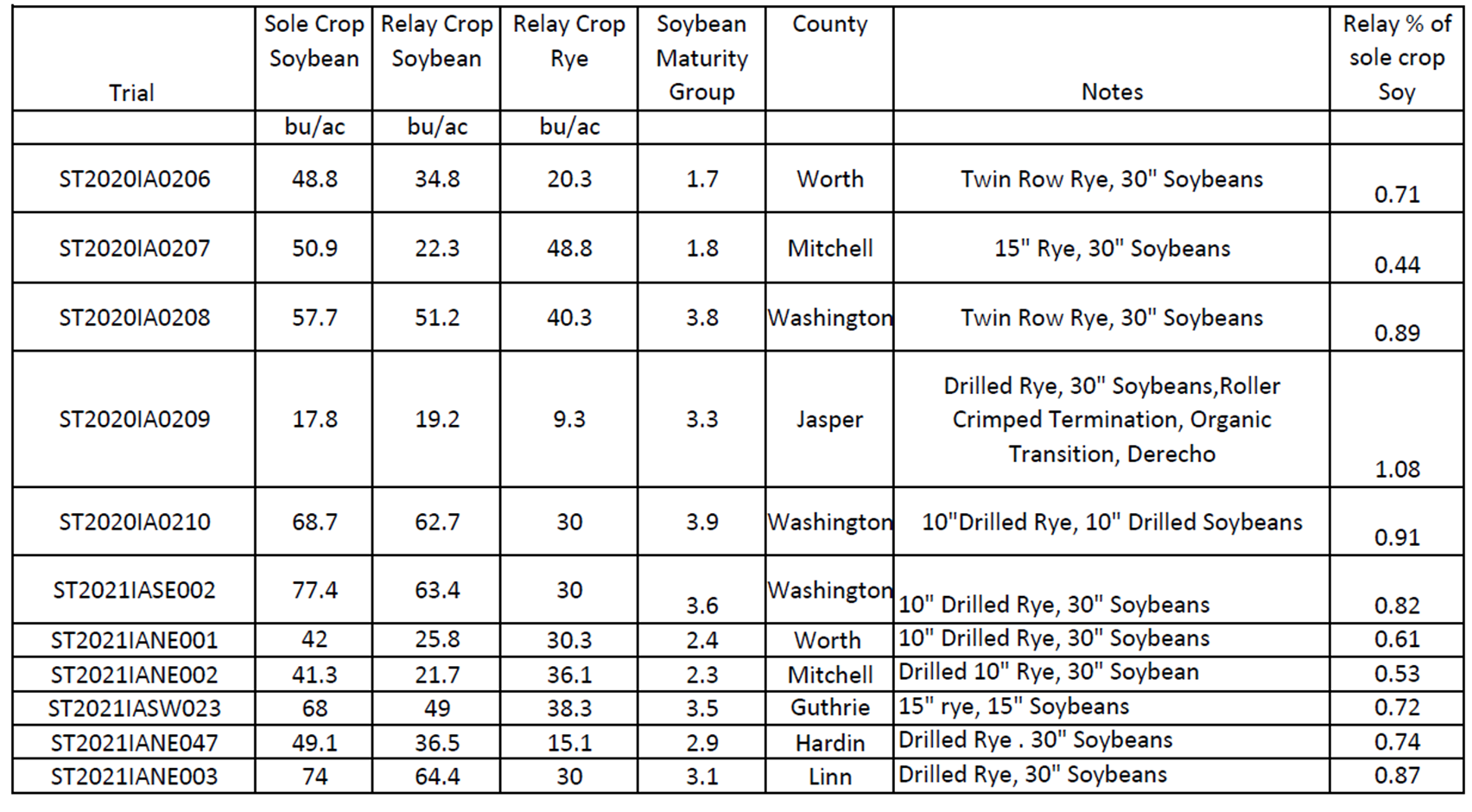
Soybeans grow in between rows of cereal rye in a relay cropping trial being conducted near Northwood. Plans are to harvest the rye near the end of July. (Photo credit: Kriss Nelson/Iowa Soybean Association)
Can relay cropping work in Iowa?
July 14, 2022 | Kriss Nelson
Relay cropping: what is it, why do it and how does it perform? Those questions and more were addressed during this week’s Innovation to Go Webinar, "Relay Cropping in Iowa: Methods and Tradeoffs."
Relay cropping can be defined as planting soybeans early in the spring into cereal rye seeded in the fall. The soybeans grow together with the rye, and when the rye reaches maturity, it is harvested above the canopy of the soybeans growing below. The soybeans then proceed to maturity, generating two-grain crops.
Theo Gunther, Iowa Soybean Association (ISA) senior research program development coordinator, has assisted producers with relay cropping trials in various parts of the state for the past two years.
“We rely on farmer-cooperators to gather data and make comparisons,” he says.
Trials vary in rye varieties, soybean relative maturity, row configurations and equipment used.

The graphic, above, is a summary of all replicated strip trials include relay rye and soybean versus sole crop soybean with information including maturity group, location and row configuration for each site.
Four trials show soybeans yielding 80- to 91% of the sole crop.
“That shows the potential of the system,” says Gunther. “Often, this is after getting between 30-40 bushels to the acre of rye off those same acres. Those are some of the most profitable acres on their farms when they can achieve that soybean yield compared to a sole crop and have an additional 30-40 bushels to the acre of cereal rye. That offsets their cost to maintain that practice on their farm or sell the seed. That’s where this system shines in terms of profitability.”
Gunther says it can be due to a lower relative maturity group of soybeans planted, weather and the farmer’s goals in the relay crop scenario vs. a sole soybean crop.
“In some locations, where the farmer was growing rye for seed, they want as much soybean yield as they can, but that is not their primary goal,” he says.
Soy considerations
Gunther says when selecting soybean seed for a relay crop situation, a producer needs to consider taking advantage of the entire growing season, recognizing these will be the first soybeans planted and the last out of the field.
“You want to be at the high end of your relative maturity for your area,” he says. “Maybe a half a group higher or more. This is to ensure you take advantage of the growing season. Plant them as soon as possible.”
Gunther says to keep in mind that soybeans in a sole crop situation will be larger than the relay soybeans at the time of the rye harvest.
“Once that rye canopy is removed, there is still plenty of time left on the clock if you have a longer relative maturity soybean,” he says. “There is the end of July through the end of September, sometimes beginning of October to finish those soybeans out.”
Why relay crop?
Gunther says there are environmental and economic benefits to relay cropping soybeans and cereal rye.
Environmental benefits include:
- Soil cover and stabilization
- Lower nitrogen loss to water
- Increase total biomass input of the cropping system
“This system provides the same way small grain cover crops works,” says Gunther. “You have something growing immediately after the ground thaws in the spring using nutrients and water that otherwise would be turned into a loss.”
Economic benefits include:
- Two harvested and marketable grain crops
- Lower herbicide needs: “None of the trial sites are using a pre-emergent herbicide program,” says Gunther. “They are often just doing a post-rye harvest herbicide application.”
- Nitrogen and water drained become biomass and grain: “You are turning nitrogen and water that could otherwise be lost in the system into biomass and grain that becomes a marketable product,” says Gunther.
Gunther says other crops, including wheat and canola, are being researched in relay cropping scenarios.
Although the idea of growing multiple plants together at the same time is not new, it is the market, application, and taking different management options using them to maximize yield potential and giving you the ground cover and environmental benefits that should be considered.
“For farmers considering relay cropping, you have a lot of things to think about,” he says. “If you are curious how it might perform in a specific field, it can be considered for research and could be worked on with ISA.”
For more information, contact: Alex Schaffer, ISA field services program manager, at 815-274-2998 or aschaffer@iasoybeans.com or Anthony Martin, ISA senior field services program manager, at 515-334-1048 or amartin@iasoybeans.com.
2022 Innovation To Go Webinar series
ISA’s Innovation To Go Webinar series continues throughout the summer.
Drainage Water Recycling for Crop Production and Water Quality
Tuesday, Aug. 2 | 12-1 p.m.
Drainage water recycling captures and stores drainage water for reuse as supplemental irrigation. This practice can both improve crop production as well as benefit water quality. This webinar will cover what ISA researchers have learned about this practice and some of the remaining questions as we look at the potential feasibility of this practice in Iowa. Register here for this event.
Keys to Improved Soil Health, Water Quality, and Profitability
Tuesday, Sept. 13 | 12-1 p.m.
Join ISA RCFI conservation agronomists as they discuss their role in assisting farmers and landowners with adopting conservation practices. An interactive panel discussion will highlight the value of cover crops and edge-of-field practices in improving soil health and water quality and increasing farmer profitability. Engage with our network of conservation agronomists to learn about available cost-share resources and more. Register here for this event.
Visit this page for more information.
Back